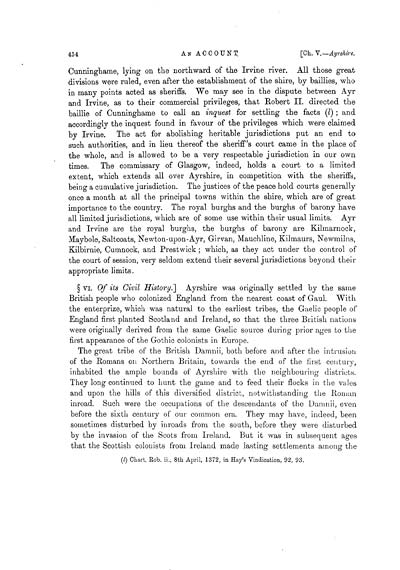Volume 6
(12) Page 454
Download files
Individual page:
Thumbnail gallery: Grid view | List view

454 Cunningbame, lying on the northward of the Irvine river. All those great divisions were ruled, even after the establishment of the shire, by baillies, who in many points acted as sheriffs. We may see in the dispute between Ayr and Irvine, as to their commercial privileges, that Robert II. directed the baillie of Cunninghame to call an inquest for settling the facts (l); and accordingly the inquest found in favour of the privileges which were claimed by Irvine. The act for abolishing heritable jurisdictions put an end to such authorities, and in lieu thereof the sheriff's court came in the place of the whole, and is allowed to be a very respectable jurisdiction in our own times. The commissary of Glasgow, indeed, holds a court to a limited extent, which extends all over Ayrshire, in competition with the sheriffs, being a cumulative jurisdiction. The justices of the peace hold courts generally once a month at all the principal towns within the shire, which are of great importance to the country. The royal burghs and the burghs of barony have all limited jurisdictions, which are of some use within their usual limits. Ayr and Irvine are the royal burghs, the burghs of barony are Kilmarnock, Maybole, Saltcoats, Newton-upon-Ayr, Girvan, Mauchline, Kilmaurs, Newmilns, Kilbirnie, Cumnock, and Prestwick; which, as they act under the control of the court of session, very seldom extend their several jurisdictions beyond their appropriate limits. � VI. Of its Civil History.] Ayrshire was originally settled by the same British people who colonized England from the nearest coast of Gaul. With the enterprize, which was natural to the earliest tribes, the Gaelic people of England first planted Scotland and Ireland, so that the three British nations were originally derived from the same Gaelic source during prior ages to the first appearance of the Gothic colonists in Europe. The great tribe of the British Damnii, both before and after the intrusion of the Romans on Northern Britain, towards the end of the first century, inhabited the ample bounds of Ayrshire with the neighbouring districts. They long continued to hunt the game and to feed their flocks in the vales and upon the hills of this diversified district, notwithstanding the Roman inroad. Such were the occupations of the descendants of the Damnii, even before the sixth century of our common era. They may have, indeed, been sometimes disturbed by inroads from the south, before they were disturbed by the invasion of the Scots from Ireland. But it was in subsequent ages that the Scottish colonists from Ireland made lasting settlements among the (l) Chart. Bob. ii., 8th April, 1372, in Hay's Vindication, 92, 93.
Set display mode to:
![]() Universal Viewer |
Universal Viewer | ![]() Mirador |
Large image | Transcription
Mirador |
Large image | Transcription
Images and transcriptions on this page, including medium image downloads, may be used under the Creative Commons Attribution 4.0 International Licence unless otherwise stated. ![]()
| Caledonia, or, An account, historical and topographic of North Britain from the most ancient to the present times > Volume 6 > (12) Page 454 |
|---|
| Permanent URL | https://digital.nls.uk/74531054 |
|---|---|
| Description | Of its civil history |
| Description | Vol. VI. |
|---|---|
| Attribution and copyright: |
|

